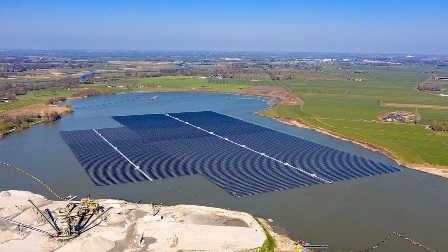
Floating Solar Panel Market – Global Forecasts from 2022 to 2027: Market to Reach $3.21 Billion from $376 Million in 2020
DUBLIN–(BUSINESS WIRE)–The “Floating Solar Panel Market – Forecasts from 2022 to 2027” report has been added to ResearchAndMarkets.com’s offering.
The floating solar panel market was valued at US$376.827 million in 2020 and is expected to grow at a CAGR of 35.86% over the forecast period to reach a total market size of US$3219.996 million by 2027.
In various economies, the inclination towards clean energy with floating solar panels is expected to be a major growth driver. In 2019, solar photovoltaic was the second-largest absolute generator of energy in the US, followed by wind power and ahead of hydropower, which drove the growth of floating solar power generation by 22% (+131 TWh).
Various factors, such as subsidies and tax incentives offered by the government to purchase and install solar panels, as well as rental benefits offered to reservoir owners, are expected to fuel the demand for solar photovoltaic (PV) panels. Further, the scarcity of open land and the growing use of water resources such as reservoirs, ponds, canals, and rivers for floating solar panel installations are expected to spur the market’s growth.
In addition, floating solar panels have low maintenance and management costs. By 2020, there will be 230,000 Americans working in the solar industry, with more than 10,000 companies in every state in the country. A $25 billion investment in the solar industry is expected for the U.S. economy in 2020. If floating solar panels were added to bodies of water that already have hydroelectric plants, the researchers estimate that a potential annual output of 10,600 terawatt-hours could be generated by installing solar PV systems alone.
Solar panels are expected to grow in Japan, China, and India due to the growing investments in floating panels along with favourable regulatory support. During the forecast period, the South Korean, Malaysian, Australian, and Maldivian governments are all expected to increase their investments in floating solar panel plants.
As a result of the Yamakura Dam project in Japan, floating solar panels are expected to be in demand in Japan. Likewise, the Uttar Pradesh government in India announced that they would be developing a 150 megawatt (MW) floating solar power project in the near future.
Growth Factors
Investments in floating solar panels continue to grow
Manufacturing companies are investing more in ways to improve the efficiency of solar panels, which is a prominent trend in the floating panels market.
Additionally, governments worldwide are investing in this technology because floating solar panels save money since they do not need land. Many of the projects scheduled to start construction within the next few years, such as Vietnam’s 475 MW project, South Korea’s 2.1 gigawatt (GW) project, and several others, are likely to be completed in the near future.
Additionally, Singapore, which has a land area of over 700 sq. km and a population of over 5.70 million, is agitatedly working to deploy new floating solar panels. Singapore is building one of the world’s largest floating solar panel farms in July 2021, occupying an area the size of 45 football fields and generating enough electricity to power five of the island’s five water treatment plants.
Similarly, a 120-MW floating solar photovoltaic plant (FSPV) has been built by Jinko18 in Poyang Lake that is spread over 2000 acres of water and generates 137.70 GWh of electricity. Currently, China has 73% of the world’s installed FSPV capacity, making it the leading country in that industry.
In addition, regulations to curb GHG emissions will boost the market in the forecast period. China announced in its 13th 5-year plan in 2016 that it plans to reduce emissions by 18% by 2020. In the forecast period, the factors aforesaid will propel the floating solar panel market’s growth.
Restraints
Disturbance of aquatic life
A solar panel’s surface is designed to be waterproof, but exposure to water 24/7 can negatively impact the panels. In the event of a panel break, water will cause more damage. However, this potential downside is insufficient to prevent floating solar panels from being installed. Since the panels could block the sun from illuminating all of the water, they could disturb aquatic life. Due to their structure, the solar panels have the potential to disturb aquatic life by blocking sunlight from reaching the whole surface of the water.
COVID-19 insight
As a result of business restrictions, travel restrictions, and border closures, transportation, and manufacturing energy usage fell sharply, reducing the reliance on renewable energy. The renewable industry, including solar energy, is subject to risks from pandemic-related shutdowns. Yet, with nations reviving their economies, the construction of floating solar panels has resumed, showing steady improvement.
Key Topics Covered:
1. INTRODUCTION
2. RESEARCH METHODOLOGY
3. EXECUTIVE SUMMARY
4. MARKET DYNAMICS
4.1. Market Drivers
4.2. Market Restraints
4.3. Porters Five Forces Analysis
4.4. Industry Value Chain Analysis
5. FLOATING SOLAR PANELMARKET, BY DELIVERY TYPE
5.1. Introduction
5.2. Stationary Floating Solar Panels
5.3. Tracking Floating Solar Panels
6. FLOATING SOLAR PANELMARKET, BY DEPLOYMENT
6.1. Introduction
6.2. Onshore
6.3. Off Shore
7. FLOATING SOLAR PANELMARKET, BY GEOGRAPHY
7.1. Introduction
7.2. North America
7.2.1. United States
7.2.2. Canada
7.2.3. Mexico
7.3. South America
7.3.1. Brazil
7.3.2. Others
7.4. Europe
7.4.1. Germany
7.4.2. France
7.4.3. United Kingdom
7.4.4. Others
7.5. Middle East and Africa
7.5.1. Turkey
7.5.2. Egypt
7.5.3. South Africa
7.5.4. Others
7.6. Asia Pacific
7.6.1. China
7.6.2. India
7.6.3. South Korea
7.6.4. Japan
7.6.5. Others
8. COMPETITIVE ENVIRONMENT AND ANALYSIS
8.1. Major Players and Strategy Analysis
8.2. Emerging Players and Market Lucrativeness
8.3. Mergers, Acquisition, Agreements, and Collaborations
8.4. Vendor Competitiveness Matrix
9. COMPANY PROFILES
- Kyocera TCL
- Trina Solar
- Solaris Synergy
- Swimsol
- Vari Pontoon Pvt Ltd
- Akuo Group
- Ciel & Terre International
For more information about this report visit https://www.researchandmarkets.com/r/wv5r4t
Contacts
ResearchAndMarkets.com
Laura Wood, Senior Press Manager
press@researchandmarkets.com
For E.S.T Office Hours Call 1-917-300-0470
For U.S./CAN Toll Free Call 1-800-526-8630
For GMT Office Hours Call +353-1-416-8900



